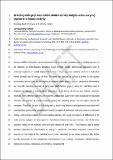Files in this item
Breeding male grey seals exhibit similar activity budgets across varying exposures to human activity
Item metadata
| dc.contributor.author | Bishop, Amanda | |
| dc.contributor.author | Pomeroy, Patrick | |
| dc.contributor.author | Twiss, Sean D. | |
| dc.date.accessioned | 2016-05-06T23:32:10Z | |
| dc.date.available | 2016-05-06T23:32:10Z | |
| dc.date.issued | 2015-05-07 | |
| dc.identifier | 212936047 | |
| dc.identifier | 3480a0c2-7ef2-421f-b825-a24932b5c868 | |
| dc.identifier | 000354395700019 | |
| dc.identifier | 84930711494 | |
| dc.identifier | 000354395700019 | |
| dc.identifier.citation | Bishop , A , Pomeroy , P & Twiss , S D 2015 , ' Breeding male grey seals exhibit similar activity budgets across varying exposures to human activity ' , Marine Ecology Progress Series , vol. 527 , pp. 247-259 . https://doi.org/10.3354/meps11254 | en |
| dc.identifier.issn | 0171-8630 | |
| dc.identifier.other | ORCID: /0000-0003-1603-5630/work/46569083 | |
| dc.identifier.uri | https://hdl.handle.net/10023/8751 | |
| dc.description.abstract | Human-wildlife interactions can be incidental or direct through activities such as wildlife tourism. In the presence of anthropogenic activities, some animals exhibit behavioural alterations such as increased vigilance or spatial displacement. Thus, chronic exposure could be adverse to individual fitness through loss of energy or time. Pinnipeds are exposed to human activities in the aquatic environment and on land, but the degree of exposure varies across a species' geographic distribution. For example, breeding colonies of grey seals Halichoerus grypus along the mainland coast of England are exposed to anthropogenic disturbance in the forms of tourism and military activities; however, many offshore colonies are relatively undisturbed. Due to the recent expansion of mainland colonies, the impacts of human presence during the breeding season are of urgent interest for managers. Therefore, the aim of this study was to test for any behavioural adjustments associated with anthropogenic presence by comparing the activity budgets of individual male grey seals at a mainland colony with activity budgets from 2 isolated colonies. We found no evidence of differences in the male activity budgets for time spent in non-active behaviours across colonies, and of the 3 colonies, males on the mainland spent the least amount of time alert. This indicates that as capital breeders, selection for conservation of energy is potentially overriding short-term costs of local stressors or that males at the mainland colony have habituated to human presence. Our results demonstrate the importance of understanding species-and life history-stage-specific selection pressures when considering management actions. | |
| dc.format.extent | 13 | |
| dc.format.extent | 703114 | |
| dc.language.iso | eng | |
| dc.relation.ispartof | Marine Ecology Progress Series | en |
| dc.subject | Wildlife tourism | en |
| dc.subject | Halichoerus grypus | en |
| dc.subject | Behaviour | en |
| dc.subject | Conservation | en |
| dc.subject | Management | en |
| dc.subject | QH301 Biology | en |
| dc.subject | NDAS | en |
| dc.subject.lcc | QH301 | en |
| dc.title | Breeding male grey seals exhibit similar activity budgets across varying exposures to human activity | en |
| dc.type | Journal article | en |
| dc.contributor.sponsor | NERC | en |
| dc.contributor.institution | University of St Andrews. School of Biology | en |
| dc.contributor.institution | University of St Andrews. Sea Mammal Research Unit | en |
| dc.contributor.institution | University of St Andrews. Marine Alliance for Science & Technology Scotland | en |
| dc.contributor.institution | University of St Andrews. Scottish Oceans Institute | en |
| dc.contributor.institution | University of St Andrews. Centre for Research into Ecological & Environmental Modelling | en |
| dc.identifier.doi | 10.3354/meps11254 | |
| dc.description.status | Peer reviewed | en |
| dc.date.embargoedUntil | 2016-05-07 | |
| dc.identifier.grantnumber | Agreement R8-H12-86 | en |
This item appears in the following Collection(s)
Items in the St Andrews Research Repository are protected by copyright, with all rights reserved, unless otherwise indicated.

